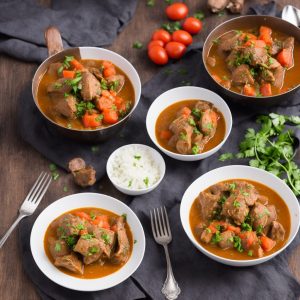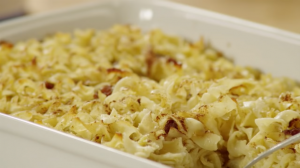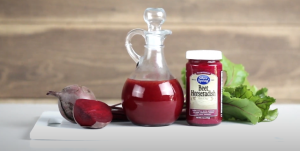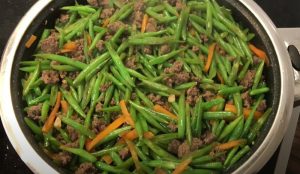A hearty and flavorful dish, hasenpfeffer rabbit stew is perfect for those who enjoy rich, comforting meals. Combining the unique flavors of rabbit meat with savory bacon and an aromatic blend of spices, this traditional German stew is sure to please your taste buds.
Photos of Hasenpfeffer (Rabbit Stew) Recipe
Some of the ingredients in this recipe may not be common in every household. Specifically, rabbit meat might require a visit to a specialty butcher or a store with a well-stocked meat section. Currant jelly and shallots are other items that may need to be sought out in a supermarket. Ensure you have these unique ingredients on hand to achieve the authentic flavor of hasenpfeffer.
Ingredients for Hasenpfeffer Rabbit Stew
rabbit meat: A lean and tender meat that is the star of this stew.
salt: Enhances the flavor of the rabbit and other ingredients.
all-purpose flour: Used for coating the rabbit and thickening the gravy.
bacon: Adds a smoky and savory note to the stew.
shallots: Provide a mild and sweet onion flavor.
garlic clove: Adds depth and aromatic flavor.
dry red wine: A robust liquid that enhances the stew’s flavor profile.
water: Helps in creating the stew’s broth.
chicken bouillon granules: Concentrated flavor enhancer for the broth.
currant jelly: Adds a touch of sweetness and balance.
black peppercorns: Impart a subtle heat and complexity.
bay leaf: Infuses the stew with a mild herbal essence.
rosemary: Adds an earthy, aromatic note.
lemon juice: Brightens the flavors of the stew.
thyme: Offers a light, aromatic flavor to the gravy.
One reader, Jareb South says:





This hasenpfeffer rabbit stew recipe is a delightful culinary adventure. The flavors meld beautifully, and the tender rabbit paired with the rich gravy is simply divine. The addition of currant jelly adds a unique sweetness that elevates the dish. Perfect for a cozy dinner!
Key Techniques for Preparing Hasenpfeffer Rabbit Stew
How to cook bacon: Place bacon in a large, deep skillet and cook over medium-high heat until evenly brown. Drain on paper towels and set aside.
How to coat meat with flour: Sprinkle rabbit with salt and coat with ⅓ cup of flour, shaking off excess.
How to brown meat: Brown rabbit in remaining bacon fat.
How to sauté: Sauté shallots and garlic in skillet for about 4 minutes until tender.
How to make a gravy: Stir lemon juice into the skillet with cooking liquid. Combine 3 tablespoons water with 2 tablespoons flour and mix together; stir mixture into skillet over low heat. Finally, stir in thyme.
How To Make Hasenpfeffer (Rabbit Stew)
If you’re looking for a unique meal, this rabbit stew recipe is easy to make with premium rabbit meat along with bacon, wine, shallots, and others.
Serves:
Ingredients
- 3lbsrabbit meat,cleaned and cut into pieces
- ½tspsalt
- ⅓cupall-purpose flour
- ½lbbacon,diced
- ½cupshallots,finely chopped
- 1garlic clove,finely chopped
- 1cupdry red wine
- 1cupwater
- 1tbspchicken bouillon granules
- 1tbspcurrant jelly
- 10black peppercorns,crushed
- 1bay leaf
- ¼tsprosemary,dried, crushed
- 2tsplemon juice
- 3tbspwater
- 2tbspall-purpose flour
- ⅛tspthyme,dried, crushed
Instructions
-
Place bacon in a large, deep skillet. Cook over medium-high heat until evenly brown. Drain on paper towels and set aside. Sprinkle rabbit with salt and coat with ⅓ cup of flour, shaking off excess.
-
Brown rabbit in remaining bacon fat. Remove from skillet along with all but 2 tablespoons of the fat and reserve.
-
Saute shallots and garlic in skillet for about 4 minutes until tender. Stir in wine, 1 cup water, and bouillon. Heat to boiling then stir in jelly, peppercorns, bay leaf, and rosemary.
-
Return rabbit and bacon to skillet. Heat to boiling, then reduce heat to low. Cover and let simmer for about 1½ hours or until the rabbit is tender.
-
Remove bay leaf and discard. Place rabbit on a warm platter and keep warm while preparing gravy.
-
To make the gravy, stir lemon juice into the skillet with cooking liquid. Combine 3 tablespoons water with 2 tablespoons flour and mix together; stir mixture into skillet over low heat.
-
Finally, stir in thyme. Pour gravy over stew and serve or pour into a gravy boat and serve on the side.
Nutrition
- Calories: 837.63kcal
- Fat: 41.81g
- Saturated Fat: 13.28g
- Trans Fat: 0.08g
- Monounsaturated Fat: 15.10g
- Polyunsaturated Fat: 7.48g
- Carbohydrates: 21.29g
- Fiber: 1.34g
- Sugar: 5.31g
- Protein: 77.80g
- Cholesterol: 231.53mg
- Sodium: 1173.44mg
- Calcium: 73.73mg
- Potassium: 1417.08mg
- Iron: 6.95mg
- Vitamin A: 7.03µg
- Vitamin C: 3.39mg
Pro Tip for Perfecting Hasenpfeffer Rabbit Stew
When browning the rabbit in the bacon fat, make sure to do it in batches if necessary to avoid overcrowding the skillet. Overcrowding can cause the meat to steam rather than brown, which will affect the flavor and texture of the final dish.
Time-Saving Tips for Making Hasenpfeffer Rabbit Stew Recipe
Prep ingredients ahead: Chop shallots, mince garlic, and measure out spices the night before to save time.
Use pre-cut rabbit: Purchase rabbit meat that's already cut into pieces to avoid the hassle of butchering.
Simmer in a slow cooker: Transfer the rabbit and sauce to a slow cooker after browning to free up your stove and save time.
Pre-mix thickener: Combine the flour and water for the gravy in advance so it's ready to go when needed.
Batch cook bacon: Cook extra bacon and store it for future recipes to save time on prep.
Substitute Ingredients For Hasenpfeffer (Rabbit Stew) Recipe
rabbit meat - Substitute with chicken thighs: Chicken thighs have a similar texture and flavor profile, making them a good alternative for rabbit meat in stews.
salt - Substitute with sea salt: Sea salt can be used in the same quantity and provides a similar flavor.
all-purpose flour - Substitute with cornstarch: Cornstarch can be used as a thickening agent in place of flour, though you may need to use slightly less.
bacon - Substitute with pancetta: Pancetta offers a similar smoky flavor and texture, making it a suitable replacement for bacon.
shallots - Substitute with yellow onions: Yellow onions can provide a similar sweetness and depth of flavor as shallots.
garlic clove - Substitute with garlic powder: Garlic powder can be used in place of fresh garlic, though you may need to adjust the quantity.
dry red wine - Substitute with beef broth: Beef broth can mimic the depth and richness of red wine without the alcohol content.
water - Substitute with vegetable broth: Vegetable broth can add more flavor compared to plain water.
chicken bouillon granules - Substitute with vegetable bouillon granules: Vegetable bouillon provides a similar umami flavor and is a good alternative for those avoiding meat products.
currant jelly - Substitute with grape jelly: Grape jelly can provide a similar sweetness and consistency as currant jelly.
black peppercorns - Substitute with ground black pepper: Ground black pepper can be used in place of whole peppercorns, though it will integrate more fully into the dish.
bay leaf - Substitute with oregano: Oregano can provide a similar earthy flavor, though it is more potent, so use sparingly.
rosemary - Substitute with sage: Sage offers a similar aromatic quality and can be used as a substitute for rosemary.
lemon juice - Substitute with lime juice: Lime juice can provide a similar acidity and brightness as lemon juice.
water - Substitute with chicken broth: Chicken broth can add more depth of flavor compared to plain water.
all-purpose flour - Substitute with rice flour: Rice flour can be used as a gluten-free alternative to all-purpose flour for thickening.
thyme - Substitute with marjoram: Marjoram has a similar flavor profile to thyme and can be used as a substitute.
Presentation Tips for Serving Hasenpfeffer Rabbit Stew
Serve smaller portion sizes: Present the rabbit stew in elegant, shallow bowls to highlight the rich, dark gravy. Use a small portion of rabbit meat and a few pieces of bacon to create a refined and balanced plate.
Use decoration: Garnish with a sprig of fresh thyme and a twist of lemon zest to add a pop of color and a hint of freshness. Place the garnish strategically to enhance the visual appeal.
Layer flavors: Arrange the shallots and garlic around the rabbit pieces to showcase the depth of flavors. Ensure that the currant jelly and wine sauce are visibly coating the meat, adding a glossy finish.
Highlight textures: Include a crispy element by placing a small piece of the cooked bacon on top of the rabbit. This contrast in texture will elevate the dish and provide a delightful crunch.
Use high-quality serving ware: Serve the hasenpfeffer in fine china or a sleek, modern bowl to match the sophistication of the dish. The choice of serving ware should complement the colors and textures of the stew.
Create a balanced plate: Ensure that each serving has a balanced amount of rabbit, bacon, and gravy. This balance will ensure that each bite is a harmonious blend of flavors and textures.
Add a side element: Serve the rabbit stew with a small side of crusty bread or potato puree to soak up the rich gravy. This addition will provide a comforting and satisfying element to the dish.
Focus on presentation: Use a clean, white plate to make the colors of the stew stand out. Arrange the elements thoughtfully, ensuring that the rabbit is the star of the dish, with the gravy and garnishes enhancing its presentation.
Essential Kitchen Tools for Making Hasenpfeffer Rabbit Stew
Deep skillet: A large, deep skillet is essential for browning the rabbit and cooking the bacon. It provides enough space to sauté the shallots and garlic and to simmer the stew.
Paper towels: Used for draining the bacon after it has been cooked to remove excess grease.
Tongs: Handy for turning and removing the rabbit pieces from the skillet without damaging the meat.
Measuring spoons: Necessary for accurately measuring out the salt, chicken bouillon granules, currant jelly, rosemary, lemon juice, and thyme.
Measuring cups: Used to measure the flour, dry red wine, and water.
Knife: Essential for chopping the shallots and garlic.
Cutting board: Provides a safe surface for chopping the shallots and garlic.
Mixing bowl: Used to coat the rabbit with flour and salt.
Wooden spoon: Ideal for stirring the ingredients in the skillet.
Lid: Needed to cover the skillet while the rabbit simmers.
Warm platter: Used to keep the rabbit warm while preparing the gravy.
Small bowl: For mixing the water and flour to make the gravy thickener.
Whisk: Useful for combining the water and flour mixture smoothly.
Gravy boat: Optional, but useful for serving the gravy separately.
Storing and Freezing Hasenpfeffer Rabbit Stew
Let the hasenpfeffer rabbit stew cool completely before storing or freezing. This allows the flavors to meld and prevents the formation of condensation, which can lead to freezer burn.
Transfer the cooled stew to an airtight container or freezer-safe zip-top bag. If using a container, leave about an inch of headspace at the top to allow for expansion during freezing.
Label the container or bag with the name of the dish and the date it was prepared. This will help you keep track of how long the stew has been in the freezer.
If you plan to freeze the stew, it's best to portion it out into individual serving sizes. This makes it easier to thaw and reheat only what you need, rather than having to defrost the entire batch.
When storing the stew in the refrigerator, it will keep for up to 4 days. Make sure to place the container on a shelf towards the back of the fridge, where the temperature is most consistent.
To freeze the hasenpfeffer rabbit stew, place the airtight container or freezer-safe bag in the freezer. The stew will maintain its quality for up to 3 months.
When you're ready to enjoy the frozen stew, transfer it from the freezer to the refrigerator to thaw overnight. Alternatively, you can thaw it in the microwave using the defrost setting.
Once thawed, reheat the stew in a saucepan over medium-low heat, stirring occasionally, until it reaches the desired temperature. You may need to add a splash of water or chicken broth to thin out the consistency if it has thickened during freezing.
Do not refreeze the stew once it has been thawed, as this can compromise its texture and flavor. Consume the reheated stew within 2 days for optimal quality and safety.
How To Reheat Leftover Hasenpfeffer Rabbit Stew
- Reheat the hasenpfeffer rabbit stew in a saucepan over medium-low heat, stirring occasionally, until it reaches the desired temperature. This method ensures that the rabbit meat and vegetables are evenly heated without overcooking or drying out.
- If the stew has thickened too much during storage, add a small amount of water or chicken broth to help loosen it up and restore its original consistency.
- For a quicker reheating option, transfer individual portions of the hasenpfeffer to microwave-safe bowls and heat on high power in 30-second intervals, stirring between each interval, until the stew is heated through.
- To maintain the flavor and texture of the bacon, remove it from the stew before reheating and set it aside. Once the stew is heated, crumble the bacon over the top of each serving for a crispy contrast.
- If you have leftover gravy, reheat it separately in a small saucepan over low heat, whisking occasionally to prevent scorching. Pour the heated gravy over the reheated hasenpfeffer for an extra burst of flavor.
- For a crispy crust on top of your reheated hasenpfeffer, transfer the stew to an oven-safe dish, sprinkle with a mixture of breadcrumbs and grated Parmesan cheese, and broil for 2-3 minutes until golden brown.
- To add a fresh element to your reheated stew, garnish each serving with a sprinkle of chopped parsley or thyme, which will brighten up the flavors and add a pop of color to the dish.
Interesting Trivia About Hasenpfeffer Rabbit Stew
A unique aspect of hasenpfeffer is its use of currant jelly, which adds a subtle sweetness to the stew. This ingredient, combined with the dry red wine and bacon, creates a rich and complex flavor profile that is characteristic of traditional German cuisine.
Is Making Hasenpfeffer Rabbit Stew at Home Cost-Effective?
When evaluating the cost-effectiveness of this hasenpfeffer rabbit stew, several factors come into play. The primary ingredients, such as rabbit meat, bacon, and dry red wine, can be relatively expensive. However, the use of common pantry items like flour, shallots, and garlic helps balance the cost. For a household of four, the approximate cost is around $40-$50. Given the rich flavors and unique ingredients, the overall verdict is a 7 out of 10 for cost-effectiveness.
Is Hasenpfeffer Rabbit Stew Healthy or Unhealthy?
This hasenpfeffer rabbit stew recipe, while flavorful, leans towards the unhealthy side due to a few key ingredients and cooking methods. The use of bacon and frying the rabbit in the remaining bacon fat adds saturated fat and cholesterol to the dish. Additionally, the all-purpose flour used for coating the rabbit and thickening the gravy contributes to the carbohydrate content without providing significant nutritional value.
On the positive side, rabbit meat itself is a lean protein source, and the recipe incorporates some vegetables and herbs, such as shallots, garlic, and rosemary, which offer some nutritional benefits.
To make this recipe healthier, consider the following modifications:
- Replace the bacon with a leaner alternative, such as turkey bacon or omit it altogether and use a healthier cooking oil like olive oil
- Use whole wheat flour instead of all-purpose flour for coating the rabbit and thickening the gravy to increase the fiber content
- Increase the amount and variety of vegetables in the stew, such as carrots, celery, and mushrooms, to boost the nutrient profile
- Reduce the amount of added salt and rely more on herbs and spices for flavor
- Serve the stew with a side of whole grains, like brown rice or quinoa, to make it a more balanced meal
Editor's Opinion on the Hasenpfeffer Rabbit Stew Recipe
This hasenpfeffer rabbit stew recipe is a delightful blend of rich flavors and textures. The use of bacon adds a smoky depth, while the dry red wine and currant jelly provide a balanced sweetness and acidity. The combination of herbs like rosemary and thyme enhances the savory profile, making each bite aromatic and satisfying. The methodical steps ensure the rabbit remains tender, and the final gravy, enriched with lemon juice, ties the dish together beautifully. This recipe is a sophisticated take on a classic, perfect for a hearty, comforting meal.
Enhance Your Hasenpfeffer (Rabbit Stew) Recipe with These Unique Side Dishes:
Similar Recipes to Try If You Enjoy Hasenpfeffer Rabbit Stew
Appetizer and Dessert Pairings for Hasenpfeffer Rabbit Stew
Why trust this Hasenpfeffer (Rabbit Stew) Recipe:
This hasenpfeffer rabbit stew recipe is a time-honored classic, blending rich flavors and tender rabbit meat for a truly comforting dish. The use of bacon adds a smoky depth, while the dry red wine and currant jelly create a balanced, savory-sweet gravy. With detailed instructions and carefully selected ingredients like shallots and rosemary, this recipe ensures a delicious and authentic experience. Trust in its traditional roots and the meticulous preparation steps for a meal that will impress and satisfy.
Was this page helpful?
Have your own special recipe to share? Submit Your Recipe Today!











